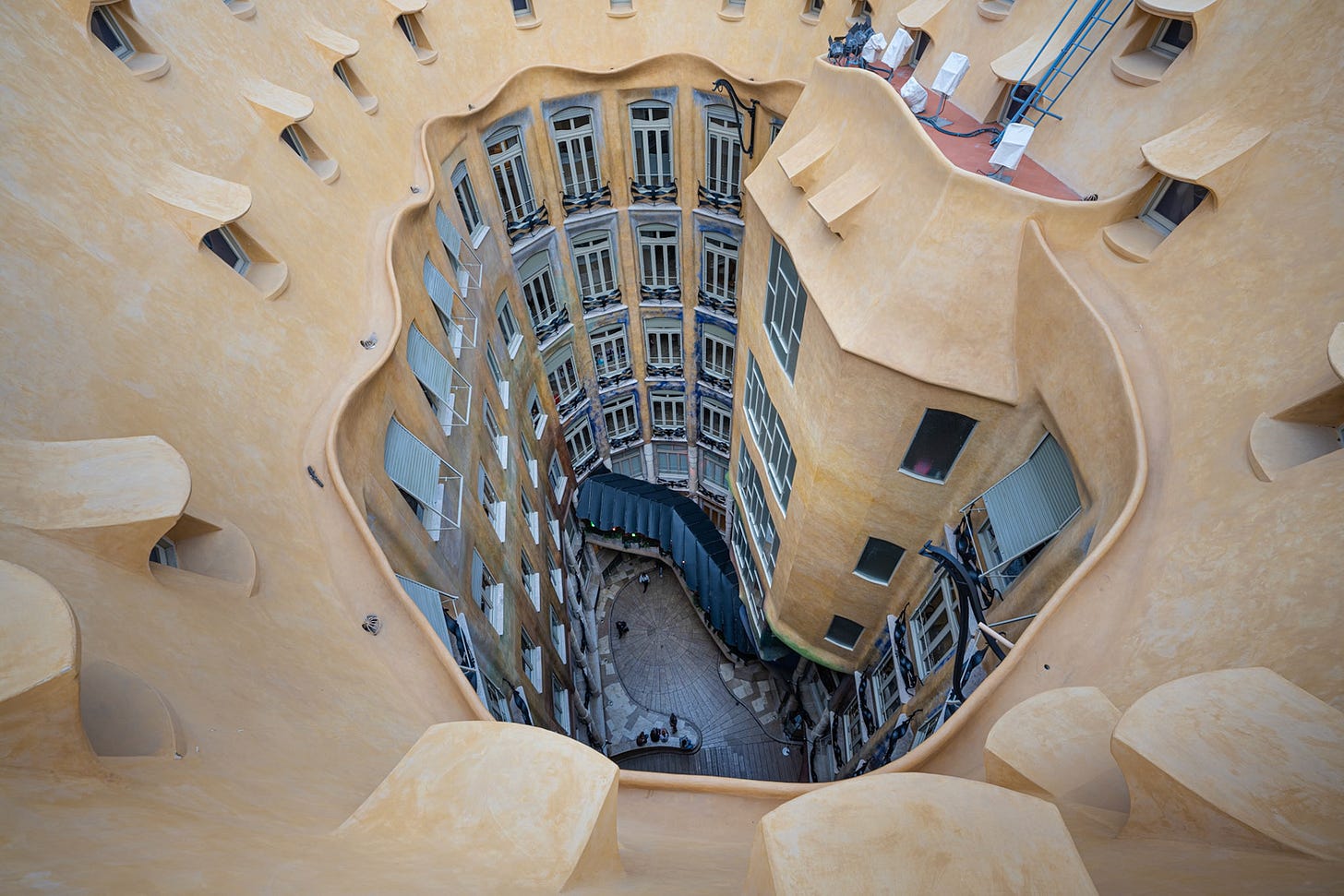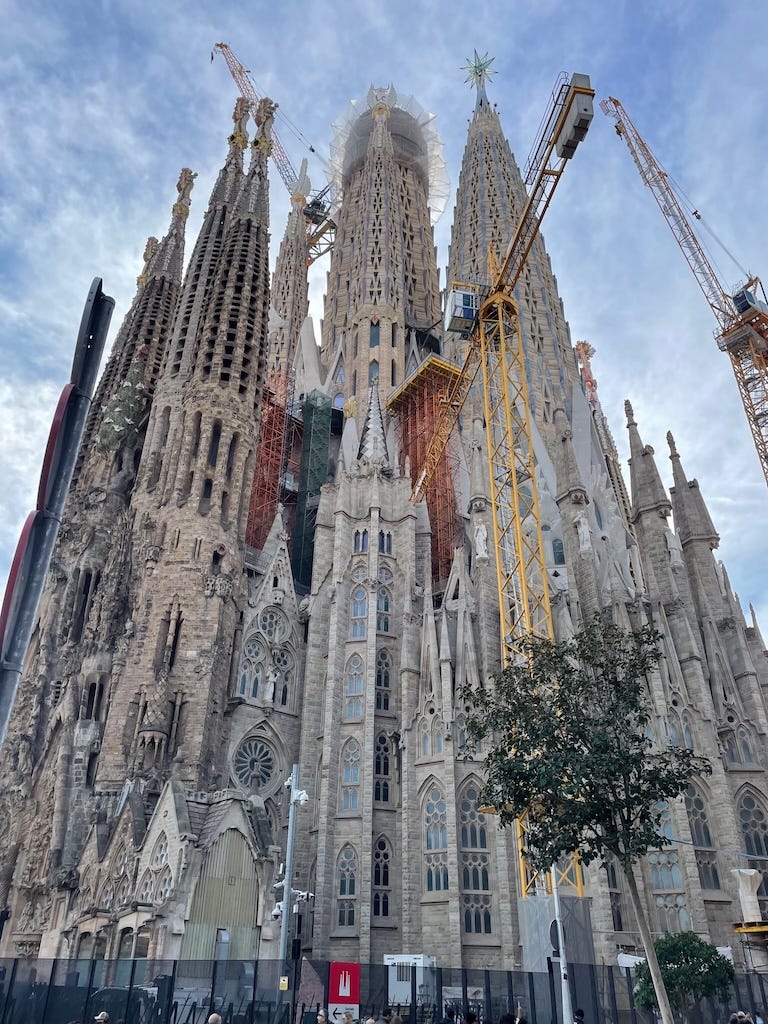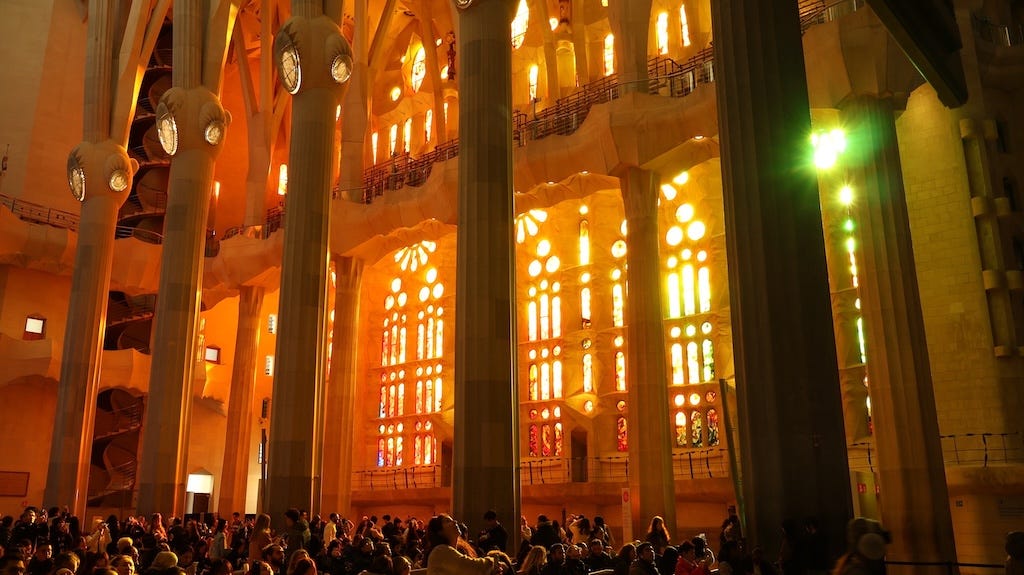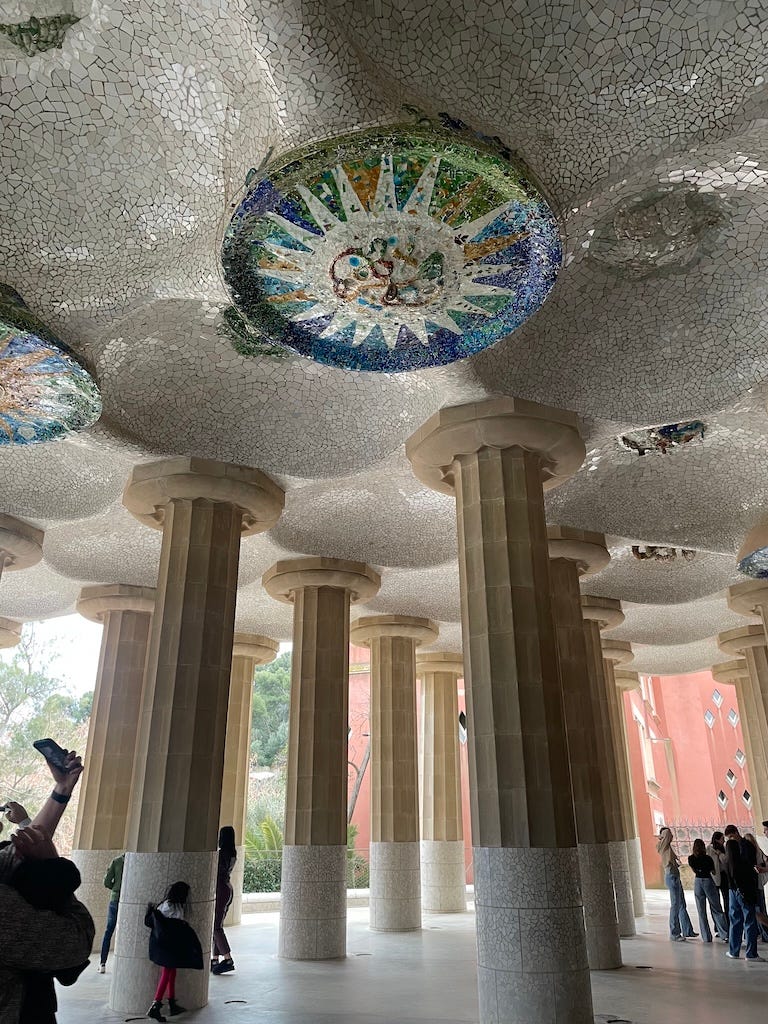Valuable Lessons From An Architect Obsessed With User-centric Design
Amazing buildings, majestic creations and a lot of inspiration from Gaudí you can adopt today.
On my last trip to Barcelona, I had the opportunity to see Gaudí's majestic creations. Gaudí was a very user-centric visionary architect whose work transcended conventional design and moved into the realm of art. I couldn't help but compare some of Gaudi's principles to product management and learn from this achievements and failures.
Gaudí wasn’t just building structures; he was crafting immersive experiences that engaged the senses and stirred the soul. Each of his buildings tells a story of innovation, spirituality, and a deep connection to nature.
📸 Picture this: It's the late 19th century in Barcelona. While other architects were busy drawing straight lines and perfect angles, there's this one guy who's obsessed with curves, nature, and making buildings that look like they're straight out of a fairy tale. That's our man, Antoni Gaudí.
Gaudí wasn't just an architect; he was like a visionary product manager avant la lettre. He understood something fundamental that many of us in the product world are still grappling with today: the importance of user experience.
Gaudí’s Approach to User-Centric Design
Let's talk about Gaudí's masterpiece, the Sagrada Familia. This is not the ordinary church you are used to. Oh no, Gaudí had bigger plans.
A Welcoming User Experience
Most of the churches of Gaudi's time were dark and gloomy, but Gaudí? He said, “Let there be light!” and so he did.
The Sagrada Familia is filled with natural light, which creates a welcoming and uplifting atmosphere. Personally, I had never been in a church before that, after admiring its unfinished masterpiece, I felt like crying.
Compared to other churches, the atmosphere of the Sagrada Familia was lighter and brighter, tender and soft. You could be surrounded by a lot of tourists and somehow feel alone and connected in the same place with each individual.
Lesson: Try to consider the user's emotional experience. How can your product make users feel welcomed and inspired?
Use Case: When designing a new feature, conduct user interviews to understand how it makes users feel. For example, if you’re developing a dashboard, ask users what emotions they associate with data visibility—do they feel overwhelmed or empowered?
Takeaway: You can create an empathy map for your users. Identify their feelings, thoughts, and behaviors related to your product. This will guide your design decisions to enhance emotional engagement.
Prioritizing Accessibility and Ergonomics
Park Güell was originally conceived as a residential project by Eusebi Güell, a wealthy industrialist who wanted to create an exclusive community of beautiful homes in the midst of nature. However, as the project progressed, it pivoted into a public park with Gaudí's signature organic forms and vibrant mosaics.
Gaudí designed the benches in Park Güell with special attention to the human form and comfort. The seats are not simple slabs of stone, but are sculpted into organic forms that perfectly fit the natural contours of the body. The sinuous lines of the benches allow for multiple seating positions, accommodating people of all ages and sizes. This design invites visitors to stop, socialize and enjoy the serene park setting.
Gaudí's ingenuity was not limited to the aesthetics and ergonomics of his designs; he also integrated advanced (for his time) engineering solutions that highlighted his understanding of sustainability. In Park Güell, he designed a rainwater collection system that took advantage of the natural topography of the land.
The park has strategically placed gutters and drains that direct rainwater to cisterns for later use, minimizing waste and encouraging water conservation.
This eco-friendly approach not only served a functional purpose but also reflected Gaudí's deep respect for nature. He believed that architecture should coexist harmoniously with the environment rather than disrupt it.
Lesson: Comfort and usability should be at the forefront of your design process, but also innovate with sustainability in mind.
Use Case: In software development, consider implementing user testing sessions where participants interact with your product for extended periods. Observe their comfort levels and gather feedback on usability.
Takeaway: You can develop a usability checklist that includes aspects like navigation ease, visual comfort, and cognitive load. Use this checklist during design reviews to ensure user-friendly experiences.
More importantly, don’t forget about the impact to the planet 🪴
Key Product Management Lessons from Gaudí
1. Embrace Nature Behavior and Patterns
Gaudí was obsessed with nature. He believed that "originality consists of returning to the origin," and for him, that origin was nature itself. He used natural forms and structures as inspiration for his designs.
Lesson: Nature has been perfecting its designs for billions of years. What can your product learn from the natural world?
Use Case: Imagine you’re building a recommendation system for a streaming platform. Users interact with your product daily—watching movies, skipping shows, or searching for specific genres. Over time, their preferences might shift, and your system needs to adapt dynamically.
Takeaway: Just like nature adjusts itself through feedback (e.g., plants growing more in areas with abundant sunlight), your algorithm can use user actions as feedback. For instance, if a user skips action movies repeatedly but finishes every documentary they start, the system should learn from this behavior and prioritize documentaries in future recommendations.
2. Prototype, Prototype, Prototype
Gaudí wasn't a fan of detailed drawings. Instead, he preferred to create three-dimensional scale models to test his ideas. He would set up workshops on-site and experiment with shapes and structures.
Lesson: Don't get stuck in the planning phase. Build prototypes, test them, and iterate. Your users will thank you!
Use Case: In software development, use tools like Figma or Maze to create interactive prototypes that can be tested with users before full-scale development begins. There’s a lot of opportunity to build something stronger now with many low-code options out there.
Takeaway: Set up a rapid prototyping cycle where you develop low-fidelity prototypes within one week and gather user feedback in the following week. This iterative process can significantly enhance product alignment with user needs.
3. Think Long-Term (Like, Really Long-Term)
The Sagrada Familia has been under construction for over 140 years and is still not finished. But Gaudí had a vision, and he knew it would take time to realize it. Even beyond his life.
Lesson: Have a long-term vision for your product, but be prepared for the journey. Rome wasn't built in a day, and neither was the Sagrada Familia.
Use Case: When setting product goals, establish both short-term milestones and long-term objectives that align with your overall vision.
Takeaway: Create a roadmap that includes both immediate deliverables and aspirational goals. Review this roadmap quarterly to adjust based on feedback and market changes.
4. Collaborate and Integrate
Gaudí often collaborated with other designers, artists, and craftsmen. He understood the value of bringing diverse skills and perspectives to a project.
Lesson: Build cross-functional teams and foster collaboration. The best products are often the result of diverse minds working together.
Use Case: Implement regular cross-departmental meetings where team members share insights from their respective domains—designers can provide input on user experience while engineers can discuss technical feasibility.
Takeaway: Use collaborative tools like Miro or Notion to create shared spaces where team members can contribute ideas and feedback throughout the product development lifecycle.
5. Care About Sustainability
Gaudí was all about sustainability. He used local materials and even recycled broken ceramic pieces in his famous trencadís technique.
*Trencadís is a mosaic technique that uses broken pieces of ceramic, glass, or other materials to create a colorful, irregular pattern.
Lesson: Consider the environmental impact of your product. Sustainability isn't just good for the planet; it's increasingly important to users as well.
Use Case: When sourcing materials or selecting technologies for development, prioritize sustainability by choosing eco-friendly options or reducing waste through efficient coding practices.
Takeaway: Develop a sustainability checklist for product decisions that evaluates environmental impact alongside cost and functionality considerations.
Challenges and Adaptability
Now let’s go back to Park Güell. Despite all of these “cool features”, as I mentioned earlier the park was originally intended to be an upscale residential community for Barcelona’s elite.
What Went Wrong With Park Güell
The park was designed to feature luxurious homes set amidst beautiful gardens and natural landscapes. However, several factors hindered its success:
Location Challenges: Situated on a rocky hill far from the city center, the area lacked adequate transportation options, making it less appealing for potential buyers. Many families found the location too remote for comfortable living.
Market Demand: The lavish design and high costs associated with the plots deterred interest. Only two homes were completed before the project was abandoned in 1914, leaving Gaudí’s grand vision unrealized.
Park Güell eventually transformed into a beloved public park, opening its gates to visitors in 1926. This teaches us that setbacks can lead to unexpected successes. Instead of viewing this project as a failure, we can see it as an opportunity for growth and adaptation—principles that are equally relevant in product management.
Takeaway: Not every product will meet initial expectations. Use setbacks as learning experiences to refine your approach and better align with user needs.
I like how Sam Kawsarani describes it here with an example:
A release isn't the finish line—it's the starting point. The sooner it's live, the sooner you can gather insights and make it better.
🚀 Example: At Railz, we debated whether Step 2 should be before or after Step 3 in a sign-up flow. Instead of delaying, we picked one, launched it, and adjusted it based on drop-off data. Instead of guessing, we had real answers in weeks.
Lastly, The Importance of Iteration
Gaudí’s work was far from linear. He believed in the iterative process, often revisiting his designs and making adjustments based on how they interacted with their environment and the people using them. The Sagrada Familia, for instance, has been under construction for over a century and continues to evolve.

"It is not a disappointment that I will not be able to finish the Temple.
I will grow old, but others will come after me.
This will make it even more grandiose."
—Antoni Gaudí
It's a living product and something that surprised me about Antoni is that he knew he wouldn't live to see his finished product and he didn't need to either. He understood that the journey of creation was just as important as the destination.
This long-term vision allows for flexibility and adaptability, ensuring that what emerges at the end is a reflection of not just one man's vision but the evolving needs of the community it serves.
Antoni Gaudí may have lived over a century ago, but his approach to design and innovation is as relevant today as it was then. I think he was a product manager before the term even existed, focusing on user experience, sustainability, and pushing the boundaries of what's possible.
I hope you liked this post, the teachings and the experience was very intimate and precious for me. I am very fortunate to be able to admire this with my own eyes.
If you have ever had the opportunity to visit these majestic creations, do it, I assure you that you will not regret it!











I love Sagrada Familia. Being there it's a living documentary of passion for design, engineering, art, people, faith... Whether you're a religious person or not, it is an out of this world experience. Definitely a place built by Product Management principles that we can learn about.
Thanks for the shoutout.